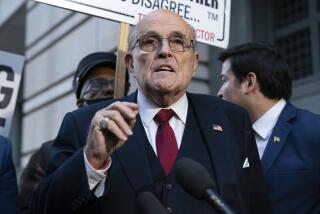A Sick Puppy : Greyhound Finds Itself Under an Aerial Attack
- Share via
Greyhound Lines, only three years out of federal Bankruptcy Court, is once again indeep trouble.
The nation’s largest intercity bus company is strapped for cash and suffering from falling ridership. Its investors and creditors are grumbling, while its stock has plunged to $2 a share from $12 earlier this year.
The situation is so dire that Greyhound intentionally missed a $4.2-million debt payment Friday so it can use the 30-day grace period on the payment to negotiate an overall refinancing plan with its creditors.
Thomas G. Plaskett, Greyhound’s chief executive, said the company has a recovery plan to obtain new financing and won’t need a return trip to Bankruptcy Court. “I don’t think that is necessary,” he said in a telephone interview.
But analysts wonder if Greyhound can reshape itself before its cash runs dry.
“Their problem is time,” said Betsy Snyder, a credit analyst with Standard & Poor’s Corp. Still, she said, Plaskett had to act. “They can’t continue to operate the way they did,” she said.
Moreover, Greyhound’s main competition--Southwest Airlines and other air carriers that provide low-cost, short-haul service--last week put even more pressure on the Dallas-based bus line by slashing its fares for travel this fall. The change came only two weeks after Greyhound had cut its fares in a bid to drum up passengers.
The airlines’ fare cuts narrowed and in some cases erased Greyhound’s traditional price advantage over air transportation, especially when one compares the rivals’ travel times.
Example: With a one-day advance ticket purchase, you can take a 75-minute Southwest flight from Burbank to Phoenix for $31. Under Greyhound’s new promotion, you can go from Los Angeles to Phoenix and back for $32--but the quickest round-trip bus ride will take 13 hours, and a seven-day advance purchase is required.
Greyhound’s relatively cheap fares still appeal to many people who have limited incomes and the time to travel by bus. (Greyhound says the average household income for its bus passengers is about $16,000 a year.)
Others like Greyhound because the buses still stop at small towns bypassed by even short-hop airlines such as Southwest. And some prefer the bus for aesthetic reasons.
“You can kick back and enjoy the scenery,” Martel Castaneda, a 27-year-old Hawthorne resident, said last week as he waited at the Downtown Los Angeles bus terminal for a Greyhound trip to Las Vegas.
Also waiting was Connie Ramos, 60, who wanted to ride Greyhound only to Claremont, less than 40 miles away, because “I don’t have to worry about being on the freeway.” Ramos said she also makes frequent trips on Greyhound to San Ysidro, at the Mexican border, for $17 round-trip.
But for a growing number of travelers, time is more important than money, and Greyhound’s volume is expected to drop to between 14.5 million and 15 million passengers this year, from 15.4 million in 1993.
In the first eight months of this year, Greyhound’s load factor--the percentage of its available seats that were filled with passengers--slumped to 51% from 57% in the comparable period of 1993.
What to do? Besides looking for new financing from creditors, Plaskett is shrinking Greyhound’s operations in order to cut its costs and focus on selected heavily populated markets, where the company hopes to undercut the airlines on price but still turn a profit.
Greyhound will concentrate on routes between 100 and 400 miles long--the average Greyhound trip is already 375 miles--in such areas as Southern California, the Northeast, the South, the Midwest and parts of Texas.
The plan also calls for Greyhound to eliminate up to 1,000 jobs, or nearly 10% of its work force, and to reduce its bus fleet by 200, to 1,700 vehicles, during the next 12 months. (A drivers strike, which led to Greyhound’s bankruptcy filing in 1990, ended in April, 1993, when Greyhound and the drivers union agreed on a new six-year contract.)
Some public policy analysts have worried about Greyhound’s prospects, because they view the company as crucial transportation for low-income travelers. Plaskett, too, says that “there is an argument that can be made that we do provide an essential service for quite a few people.”
That role, he said, even suggests that the federal government might want to provide Greyhound with “loan guarantees and other kinds of non-cash assistance that would help us continue service.” In other words, a bailout.
But Plaskett added, “I don’t see that happening.”
Plaskett ran Pan American World Airways for three years until 1991, when the famed airline ceased operations because of several factors. Some were beyond Plaskett’s control, such as the bombing of a Pan Am jet over Scotland and the Persian Gulf War, both of which eroded Pan Am’s traffic.
He was tapped to run Greyhound in August after its former chief executive, Frank J. Schmieder, resigned amid growing unrest from Greyhound’s major stockholders. He also arrived after Greyhound’s excess cash had dwindled to $1 million at the end of June.
Although the company has about $270 million in long-term debt--compared to a net worth of only $91 million--most of that debt is unsecured. So Greyhound should be able to borrow additional secured debt using its buses and other assets as collateral, giving the company breathing room, Plaskett said.
“I’m confident we’re going to get over these short-term hurdles,” he declared.
Greyhound’s Woes
Losses at Greyhound Lines are growing and its cash is dwindling as more riders abandon the bus company in favor of low-cost airlines.
Revenue (Quarterly, in millions):
1994: $151.1
Earnings (Quarterly, in millions:)
1994: $45.5
Fare Comparisons
Below are one-way fares for Greyhound and Southwest Airlines. Greyhound fares are seven-day advance-purchase; Southwest are special one-day advance-purchase fares that expire Oct. 13.
Route Greyhound Southwest New Orleans-Los Angeles $109.85 $99.00 Houston-Los Angeles $103.35 $99.00 Houston-San Francisco $109.85 $99.00 Burbank-Phoenix $20.80* $31.00 Phoenix-San Diego $22.10 $25.00
* Greyhound travels from Los Angeles to Phoenix
Source: Greyhound Lines Inc.; Southwest Airlines
More to Read
Sign up for Essential California
The most important California stories and recommendations in your inbox every morning.
You may occasionally receive promotional content from the Los Angeles Times.













